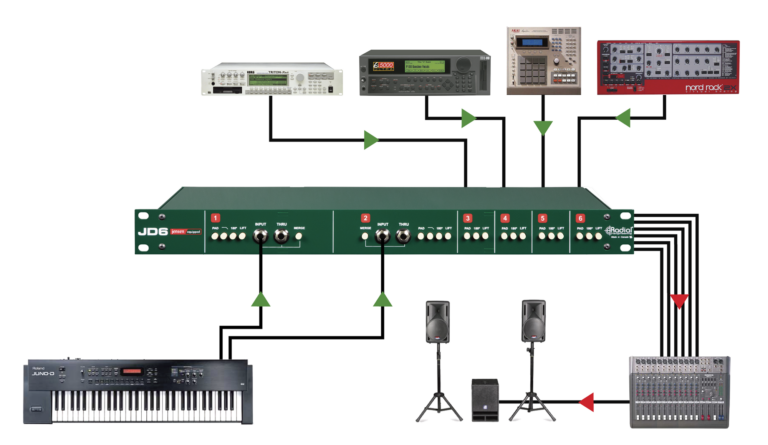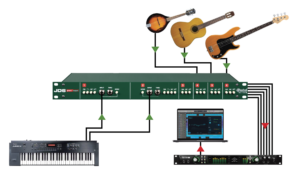JD6 FAQ
If you don't see the question you had in mind here, feel free to enter in the form provided along with your email address so we may send the reply directly to you. Thanks for your participation!
Do I really need a direct box for my keyboards? Can I not simply connect directly to a mixer?
You can certainly connect keyboards direct to a mixer. The benefit of using a direct box like the JD6 includes transformer isolation to eliminate noise while allowing you to drive long cables. By lowering the impedance and balancing the signal, you can send it to the audio system with less noise.
I heard that active direct boxes sound better than passive DIs. Is this true?
No. This misconception came from years ago before proper direct box transformers were produced. Earlier passive DIs or today’s cheaper models tend to load down the magnetic pickup. This is most audible with older passive Fender® type basses. A good active DI box like the Radial J48™ will not load the pickup, but this has no effect on buffered devices like keyboards or active instruments. There are some situations, particularly when using older low output vintage keyboards like a Rhodes® piano, where an active DI will work better. But for the most part, passive direct boxes are a better choice on keys.
Why is a passive direct box a better choice for keyboards?
There are two major benefits: First, passive DI boxes can handle greater signal without distortion than active types. This is particularly beneficial with today’s highly dynamic digital pianos and drum machines that can overload just about any active circuit. The other benefit is isolation. Transformers are amazingly effective at eliminating hum and buzz caused by ground loops.
What causes a ground loop?
Ground loops typically occur when two devices share the same audio ground and earth ground. This can often cause 60 cycle hum. A transformer allows the signal to pass via a magnetic bridge while disconnecting the electrical junction between the two devices. Putting one in line usually eliminates the ground loop.
What causes system noise?
When two electrically charged devices are connected together and a DC voltage offset is present, this can introduce clicking, popping or general noise into the system. This is common in the studio and on live stages. Good quality transformers block DC while allowing the AC (audio) to pass, making them particularly effective at eliminating noise.
Can I also use the JD6 with guitars and basses?
Yes. The JD6 employs the exact same audio circuit as the popular Radial JDI direct box and it is perfectly suited for guitars, basses and just about any instrument you can think of. The JD6 tends to be ‘typecast’ for keyboards because of the rack configuration as using multiple keyboards on stage is commonplace.
How many keyboard players does it take to change a light bulb?
Just hit auto transpose and it makes the changes for you!
Will phantom power hurt the JD6?
No. Phantom power is a low current 48-volt DC supply designed to remotely power microphones and active direct boxes. Jensen® transformers in the JD6 will block the DC from passing and will not harm the JD6.
How does the JD6 compare to the ProD8™?
Both are primarily designed for keyboards. The JD6 is a 6-channel with front panel controls, while the ProD8 is an 8-channel with reversible rack ears. The DB-1 transformer is linear from 10Hz to 40kHz, while the DB-2 is linear from 20Hz to 18.5kHz. For absolute signal integrity in the studio, the DB-1 is unsurpassed. For live touring, the DB-2 works great and saves money.
















